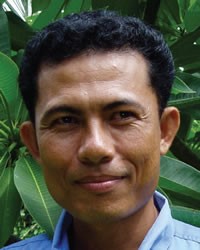Lao in Cambodia

Photo Source:
Cambodia Research Network
|
Send Joshua Project a map of this people group.
|
| People Name: | Lao |
| Country: | Cambodia |
| 10/40 Window: | Yes |
| Population: | 25,000 |
| World Population: | 4,114,000 |
| Primary Language: | Lao |
| Primary Religion: | Buddhism |
| Christian Adherents: | 1.40 % |
| Evangelicals: | 0.30 % |
| Scripture: | Complete Bible |
| Ministry Resources: | Yes |
| Jesus Film: | Yes |
| Audio Recordings: | Yes |
| People Cluster: | Lao |
| Affinity Bloc: | Southeast Asian Peoples |
| Progress Level: |
|
Introduction / History
The Lao of Cambodia, also known as the Laotian Tai, live in the lowland regions of northern Cambodia, near the border of Laos. They are primarily along the Mekong River and its tributaries. Their language, also called Lao, is a Lao-Phutai dialect of the Tai language family.
Centuries ago, the Lao lived in China. Relentless pressure by the Chinese gradually forced them southward. When the Lao Kingdom was replaced by a communist administration, many Lao fled to Myanmar, Thailand and Laos for refuge. They made their homes along the Mekong River in the eighth or ninth century and moved southward into Kampuchea (present day Cambodia).
The vast majority of the Lao live in Laos, but they are also present in many other countries, especially those in mainland Southeast Asia, like Cambodia. There is also a Lao diaspora community in many Western nations, such as the United States, Canada, France, Australia, and New Zealand.
What Are Their Lives Like?
Although Cambodia's constitution does not guarantee human rights for minority ethnic groups, the Lao in the northern provinces live peaceful lives. There is a continuous question about whether the Lao in Cambodia can be indigenous. This is a potential hot topic.
Most of them are wet-rice farmers. They also raise cotton, mulberry bushes (for silkworms), coconut palms, and various fruits. The Lao has had to become self-sufficient because of the many wars and the aftermath.
The Lao live in villages located alongside rivers or near roads that give them access to Chinese merchants. Their villages range in size from ten to several hundred families. They typically make Lao houses of bamboo strips and palm leaves. They build them high on stilts to protect against the mud and water of the rainy season. Family livestock, which includes poultry, pigs, and goats, may run freely underneath the houses. Nearly every family raises cattle and buffaloes, and they use wooden farming equipment drawn by buffalo. Some of the Lao are fishermen, and some farmers are also blacksmiths or carpenters when there is a need.
The Buddhist Wat, or temple, is the center of village life. Village leadership is usually divided; the chief has authority in secular matters, while the Buddhist monk has authority in religious issues. Lao society no longer has rigid social classes; there is no longer a hereditary elite class. Their social structure is based on family units, with no widespread lineages or clans. The people are closely attached to their customs. Sexual promiscuity before marriage is relatively common.
Lao have a variety of folk arts, and their specialty is a bamboo wind instrument called the khene. The women typically wear short-sleeved blouses and vertically striped pha sins (skirts) woven of cotton or silk. The men usually wear short-sleeved shirts and short trousers. The girls adorn their arms and necks with silver or gold jewelry.
What Are Their Beliefs?
About one-third of the Lao are Buddhist. Traditionally, young men enter village monasteries for about three months to study Buddhism. The Lao Buddhists believe that right thinking, ritual sacrifices, and self-denial will enable the soul to reach nirvana (a state of eternal bliss) at death. More than half of the Lao combine folk animism (belief that non-living objects have spirits) with Buddhism. They seek help through various supernatural beings and objects. They consider territorial deities to be important. They live in fear of their gods and constantly strive to appease them with religious chants, rituals and sacrifices. They also believe that existence is a continuing cycle of death and rebirth, or reincarnation.
What Are Their Needs?
The Lao in Cambodia need a movement to Christ that will allow them to enjoy the abundant life offered by Jesus Christ. They need freedom from fear of the spirit world.
Prayer Points
Pray for Lao in Cambodia to have open and receptive hearts, and that they would encounter the King of kings.
Pray that movements to Christ would explode, as followers make followers, and that they would place their identity in Christ.
Ask God to raise up prayer teams who will begin breaking up the spiritual soil through worship and intercession.
Ask the Lord to bring forth a vigorous Lao Church for the glory of his name!